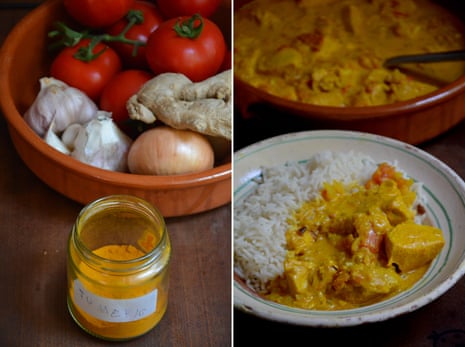The shutters remain down for some trattorie, restaurants and bars; padlocks remind us of how things were just under a month ago, how difficult things still are. Most, though, are now rolled up. And, thanks to temporary licences granted by the Commune di Roma, most places now have tables outside, often extending beyond the pavement into the road, like legs stretching after a long journey. Jaipur has eight tables on the grey cobbles of Via di San Francesco a Ripa, with long plant pots surrounding them to provide a kind of frame. The 8.30pm breeze is respite after a white-hot day.
The Guardian’s product and service reviews are independent and are in no way influenced by any advertiser or commercial initiative. We will earn a commission from the retailer if you buy something through an affiliate link. Learn more.
The Kumar family opened the restaurant in 2000, 20 years ago this September, naming it after their home city in the northern Indian State of Rajasthan. We have been sitting at their tables for 14 years, thanks to a recommendation from Vincenzo’s friend Alessandra, which means she always comes up in conversation whenever we come here – one of the many acknowledgements that link people, places and meals in a matrix of memory. Mr Kumar comes out to say hello and remembers that we usually sit in the huge back room, with its billowing silk and paintings of Jai Singh. Between us, we note how humid it is, how strange it all is.
His mask – everyone’s mask – is a reminder of the strangeness; also how much we, or rather I, rely on lip-reading to understand even the simplest thing – “fizzy water or still?”. Not that anyone is complaining – neither about the dispensers of hand sanitiser displayed on plinths near the door, nor the reservation form that needs filling out; at least, not any of the people at the eight tables. There are plastic-clad menus if we want them, also a matrix barcode to scan if you want the menu to appear on your phone, which may sound clinical when written here, but in reality is fine. Like wearing a mask or keeping your distance, this is how it has to be for now, which will of course change.
The tandoor sits in the corner of the kitchen: the cylindrical clay oven was the first thing sent from Jaipur when they were fitting out the restaurant. Hanging just near it are enormously long hooks and skewers for lifting and impaling meat. Mahender, who is part of the Chouhan family, who now co-owns Jaipur, says it is the dishes cooked in the tandoor they are most proud of – murgh tikka and haryali tikka, and their cushion-like Jaipuri naan baked, clinging to the clay, until it puffs with bubbles. The kitchen is filled with the scent of lentil masoor ki dal; and with baighan bartha – pureed aubergines cooked with spices in the tandoor. Mahender is a fan of Italian aubergines, especially with his spice additions. The scents concentrate in our masks; my glasses steam.
Back home, everything steams – even more so when we cook. The idea of food taking us home, or away, is well-worn, because it is true. Jaipur not only takes everyone who eats there to Jaipur, it is also a reminder of – and Naben Ruthnum nails it in his book Curry: Eating, Reading and Race – how the cycling story of diaspora, of human movement across great spaces, of constant dislocation and relocation, is held in mouthfuls of food; food that is always evolving, because neither the past or present is stable. Jaipur has also taught me murgh masala, as have Madhur Jaffrey in her Invitation to Indian Cooking, Meera Sodha, and Mallika Basu, whose recipe this is.
Murgh masala
Mallika Basu explains (as does Mahender about his masoor ki dal) that you can tweak this recipe to your heart’s content, especially with the spices, so you get the right primal sting of flavour and challenge, and so that it changes and evolves to suit you – wherever you are.
Prep 15 min
Cook 50 min
Serves 4
4 tbsp cooking oil
1 tsp sugar
2 medium onions, finely diced
5cm root ginger, peeled and finely grated
6 garlic cloves, peeled and grated
1 tsp turmeric
1 tsp ground cumin
1 tsp ground coriander
4 large ripe tomatoes, peeled and chopped
3 tbsp thick natural yoghurt
8 skinless chicken thighs, or 4 breasts, thickly sliced
1 tsp garam masala
Salt, to taste
Coriander leaves, to serve (optional)
Warm the oil in a frying a pan over a medium-high heat. Add the sugar and, as it melts, add the onion and cook, stirring, for five minutes. Add the ginger and garlic, and cook for five minutes more, adding a little hot water if it seems to be sticking.
Add the spices and stir, then add the tomato. Stir and cook for a few minutes, then reduce to a simmer for 10 minutes, crushing the tomatoes with the back of a spoon.
Add the yoghurt and chicken, raise the heat and stir carefully, lifting the pieces so they are coated completely in sauce. After five minutes, add 375ml warm water, stir again, lower the heat and simmer for 20-30 minutes, by which point the meat should be tender and, if you’ve used thighs, pulling away from the bone.
Remove from the heat, add the garam marsala and season with salt to taste, then serve with coriander leaves, if you wish.

Comments (…)
Sign in or create your Guardian account to join the discussion